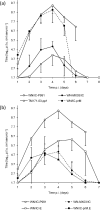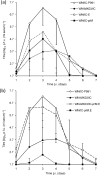Envelope and pre-membrane protein structural amino acid mutations mediate diminished avian growth and virulence of a Mexican West Nile virus isolate
- PMID: 21865445
- PMCID: PMC3352571
- DOI: 10.1099/vir.0.035535-0
Envelope and pre-membrane protein structural amino acid mutations mediate diminished avian growth and virulence of a Mexican West Nile virus isolate
Abstract
The hallmark attribute of North American West Nile virus (WNV) strains has been high pathogenicity in certain bird species. Surprisingly, this avian virulent WNV phenotype has not been observed during its geographical expansion into the Caribbean, Central America and South America. One WNV variant (TM171-03-pp1) isolated in Mexico has demonstrated an attenuated phenotype in two widely distributed North American bird species, American crows (AMCRs) and house sparrows (HOSPs). In order to identify genetic determinants associated with attenuated avian replication of the TM171-03-pp1 variant, chimeric viruses between the NY99 and Mexican strains were generated, and their replicative capacity was assessed in cell culture and in AMCR, HOSP and house finch avian hosts. The results demonstrated that mutations in both the pre-membrane (prM-I141T) and envelope (E-S156P) genes mediated the attenuation phenotype of the WNV TM171-03-pp1 variant in a chicken macrophage cell line and in all three avian species assayed. Inclusion of the prM-I141T and E-S156P TM171-03-pp1 mutations in the NY99 backbone was necessary to achieve the avian attenuation level of the Mexican virus. Furthermore, reciprocal incorporation of both prM-T141I and E-P156S substitutions into the Mexican virus genome was necessary to generate a virus that exhibited avian virulence equivalent to the NY99 virus. These structural changes may indicate the presence of new evolutionary pressures exerted on WNV populations circulating in Latin America or may signify a genetic bottleneck that has constrained their epiornitic potential in alternative geographical locations.
Figures






Similar articles
-
West Nile and St. Louis encephalitis viral genetic determinants of avian host competence.PLoS Negl Trop Dis. 2018 Feb 15;12(2):e0006302. doi: 10.1371/journal.pntd.0006302. eCollection 2018 Feb. PLoS Negl Trop Dis. 2018. PMID: 29447156 Free PMC article.
-
N-linked glycosylation of the West Nile virus envelope protein is not a requisite for avian virulence or vector competence.PLoS Negl Trop Dis. 2019 Jul 15;13(7):e0007473. doi: 10.1371/journal.pntd.0007473. eCollection 2019 Jul. PLoS Negl Trop Dis. 2019. PMID: 31306420 Free PMC article.
-
A single positively selected West Nile viral mutation confers increased virogenesis in American crows.Nat Genet. 2007 Sep;39(9):1162-6. doi: 10.1038/ng2097. Epub 2007 Aug 12. Nat Genet. 2007. PMID: 17694056 Free PMC article.
-
On the Fly: Interactions Between Birds, Mosquitoes, and Environment That Have Molded West Nile Virus Genomic Structure Over Two Decades.J Med Entomol. 2019 Oct 28;56(6):1467-1474. doi: 10.1093/jme/tjz112. J Med Entomol. 2019. PMID: 31549720 Free PMC article. Review.
-
Molecular determinants of virulence of West Nile virus in North America.Arch Virol Suppl. 2004;(18):35-41. doi: 10.1007/978-3-7091-0572-6_4. Arch Virol Suppl. 2004. PMID: 15119761 Review.
Cited by
-
Allele-specific qRT-PCR demonstrates superior detection of single nucleotide polymorphisms as genetic markers for West Nile virus compared to Luminex® and quantitative sequencing.J Virol Methods. 2014 Jan;195:76-85. doi: 10.1016/j.jviromet.2013.09.014. Epub 2013 Oct 10. J Virol Methods. 2014. PMID: 24121135 Free PMC article.
-
Increased pathogenicity of West Nile virus (WNV) by glycosylation of envelope protein and seroprevalence of WNV in wild birds in Far Eastern Russia.Int J Environ Res Public Health. 2013 Dec 12;10(12):7144-64. doi: 10.3390/ijerph10127144. Int J Environ Res Public Health. 2013. PMID: 24351738 Free PMC article. Review.
-
Mechanism of West Nile virus neuroinvasion: a critical appraisal.Viruses. 2014 Jul 18;6(7):2796-825. doi: 10.3390/v6072796. Viruses. 2014. PMID: 25046180 Free PMC article. Review.
-
Molecular Determinants of West Nile Virus Virulence and Pathogenesis in Vertebrate and Invertebrate Hosts.Int J Mol Sci. 2020 Nov 30;21(23):9117. doi: 10.3390/ijms21239117. Int J Mol Sci. 2020. PMID: 33266206 Free PMC article. Review.
-
Comprehensive mapping of common immunodominant epitopes in the West Nile virus nonstructural protein 1 recognized by avian antibody responses.PLoS One. 2012;7(2):e31434. doi: 10.1371/journal.pone.0031434. Epub 2012 Feb 9. PLoS One. 2012. PMID: 22347477 Free PMC article.
References
-
- Barrera R., Hunsperger E., Muñoz-Jordán J. L., Amador M., Diaz A., Smith J., Bessoff K., Beltran M., Vergne E., et al. & other authors (2008). First isolation of West Nile virus in the Caribbean. Am J Trop Med Hyg 78, 666–668 - PubMed
-
- Beasley D. W., Whiteman M. C., Zhang S., Huang C. Y., Schneider B. S., Smith D. R., Gromowski G. D., Higgs S., Kinney R. M., Barrett A. D. (2005). Envelope protein glycosylation status influences mouse neuroinvasion phenotype of genetic lineage 1 West Nile virus strains. J Virol 79, 8339–8347 - PMC - PubMed
Publication types
MeSH terms
Substances
Grants and funding
LinkOut - more resources
Full Text Sources
Other Literature Sources

